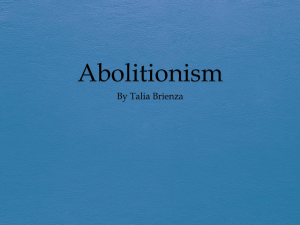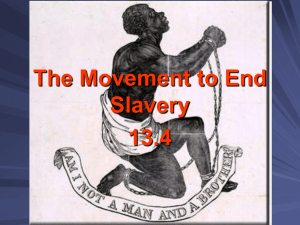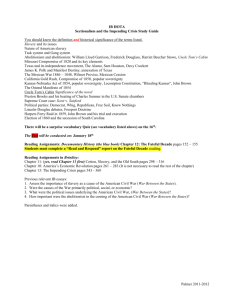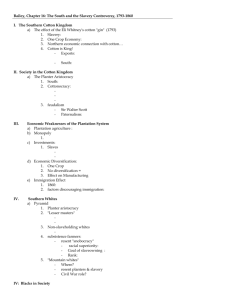File
advertisement
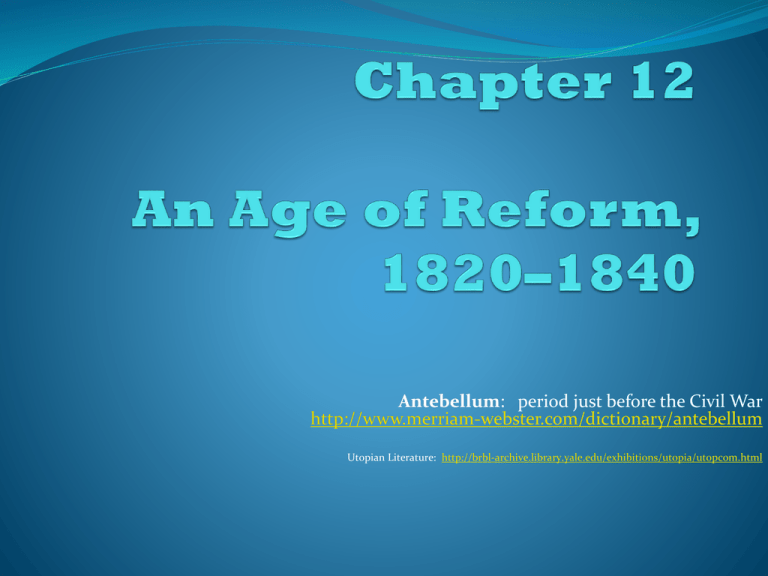
Antebellum: period just before the Civil War http://www.merriam-webster.com/dictionary/antebellum Utopian Literature: http://brbl-archive.library.yale.edu/exhibitions/utopia/utopcom.html The Reform Impulse Utopian Communities http://www.history.com/news/history-lists/5-19th-century-utopian-communities-in-the-united-states established in the years before the Civil War sought to reorganize society on a cooperative basis Structure: About 100 reform communities Governance varied: Charismatic leaders, Some Democratic Religiously motivated (most), few with secular origins Cooperative communities: productive property communally owned (not privately); introduced “socialism” and “communism” into political language Gender roles and Marriage traditions were often transformed to abolish man’s “property” over women (as they abolish private property) Socialism: government owns the means of production and distribution of goods http://www.merriam-webster.com/dictionary/socialism Communism: government owns all property (land, resources, transportation) http://www.merriam-webster.com/dictionary/communism?show=0&t=1416160748 Purpose: Reverse social and economic changes unleashed by the market revolution Restore social harmony in an increasingly individualistic society Close the widening gap between rich and poor The Reform Impulse The Shakers Moderate background: http://www.pbs.org/wnet/ihas/icon/shakers.html In depth background: http://xroads.virginia.edu/~HYPER/HNS/Cities/shakers.html In depth background: http://www.nps.gov/nr/travel/shaker/shakers.htm Most successful of the religious utopians “Shakers” (Shaking Quakers) who would dance under the influence of God Founded : Mother Ann Lee, (daughter of an English blacksmith), Christ compelled her to emigrate to America, Settlements: peek in1840s, totaling 5,000 members, from Maine – Kentucky Beliefs: Men and women were spiritual equals Non-Traditional families – Celibate (populations decrease over time due to lack of natural reproduction) Communal dorms, Men and Women live separately Structure: Rejected private property Economic success: marketed vegetable and flower seeds Cattle Furniture http://www.metmuseum.org/toah/hd/shak/hd_shak.htm Map 12.1 Utopian Communities, Mid-Nineteenth Century Give Me Liberty!: An American history, 3rd Edition Copyright © 2011 W.W. Norton & Company The Reform Impulse The Mormons’ Trek http://www.pbs.org/mormons/view/ Members of the Church of Jesus Christ of Latter-Day Saints. Founded: Joseph Smith, late 1820’s, upstate NY Beliefs: he found ancient tablets, which he transcribed as the Book of Mormon, the ancient Hebrews emigrated to the New World and were the ancestors of American Indians http://www.mrm.org/eleven-witnesses Governance & Relocation: Smith’s absolute authority over his followers and Mormons’ refusal to separate church and state alarmed many, as did their practice of polygamous marriage, in which one man could have more than one wife. http://www.pbs.org/weta/thewest/people/s_z/smith.htm The Mormons were persecuted and driven from state to state Smith’s Successor , Brigham Young led more than 10,000 Mormons to the shores of Great Salt Lake in modern-day Utah, by 1847 Background: http://www.history.com/this-day-in-history/mormons-settle-salt-lake-valley IMAGES: http://www.mormonnewsroom.org/article/mormonism-pictures-pioneers-trek-west Day in a Pioneer’s Life: http://history.lds.org/chdaily/pioneer-day-infographic-2014jpg?lang=eng The case of the Mormons showed the limits of religious toleration in nineteenth-century America http://www.pbs.org/weta/thewest/people/s_z/young.htm The Reform Impulse Oneida http://www.nyhistory.com/central/oneida.htm Founded: John Humphrey Noyes 1836 in Putney, VT then1848 in upstate NY Tried for adultery in VT, Noyes left Vermont and founded Oneida Beliefs: Noyes preached that he and his followers had achieved moral perfection and were free of sin (influenced by the revivalist message that man could achieve moral perfection) Governance & Structure: private property was abolished “complex marriage” practiced – open relationships rather than monogamy a dictatorial community ruled by Noyes, strict rules eugenics was practiced which lasted until 1881 (a committee would decide which couples could reproduce) Eugenics: regulating reproduction to “improve” the human race http://dictionary.reference.com/browse/eugenics The Reform Impulse Worldly Communities Brook Farm Founded: New England Transcendentalists in 1841 near Boston Goals: Show that manual and intellectual labor could coexist Modeled their community on the ideas of Charles Fourier, a French social reformer who planned communities with communal living and working arrangements Private property rights retained for individuals. • Culture & Structure: His settlements, called “phalanxes,” were planned to the last detail (# of residents, charges for sightseers http://www.merriam-webster.com/dictionary/phalanx Leisure Time: music, dancing, drama, intellectual discussion • Brook Farm became a salon of sorts, attracting ministers, writers, and teachers, until residents’ dislike for farm labor caused it to disband after a few years. Brook Farm: http://econc10.bu.edu/economic_systems/Theory/NonMarx_Socialism/Utopian_socialism/Brook_farm.htm http://bwht.org/brook-farm/ The Reform Impulse The Owenites Founded: by secular communitarian was Robert Owen, a British industrialist, who was appalled by early industrial conditions and 1st built a model textile factory town at New Lanark in Scotland. Scotland – 1815, textile community that was the largest center of cotton manufacturing in the world Laborers were part of a cooperative community rather than ruled over by an industrialist Robert Owen Background: http://humanistheritage.org.uk/articles/Robert-Owen/ New Harmony: http://www.indianamuseum.org/explore/new-harmony New Harmony: 1824, Owen purchased Harmony, Indiana from George Rapp who was a German Protestant leader who initially established a community in the early nineteenth century Central Beliefs: Owen envisioned a society in which all children would receive education, women would have equal rights, including access to education and divorce rights, and property would be held in common. Divisions at New Harmony: divisions over their constitution and property ended the community within a few years Impact: Owenism influenced the early labor movement, educational reforms, and women’s rights advocates. Other Communites – Anarchist: Other secular communities included Josiah Warrens anarchist communities of Utopia, Ohio, and Modern Times, New York, He believed that all institutions that exercise power over individuals are illegitimate, even government. The Reform Impulse Religion and Reform Most Americans saw private property as the basis of economic independence and freedom and marriage as the basis of the social order, so they were unlikely to join these utopian communities. Common Reform Movements: Abolition, women’s rights, temperance, asylums Many of these movements were inspired by the religious revivalism of the Second Great Awakening, which encouraged people to believe that sinners were “free moral agents” who could reform and “perfect” both themselves and the world. Background on 2nd Great Awakening: http://www.let.rug.nl/usa/outlines/history-1994/the-formation-of-a-national-government/the-second-great-awakening.php The Reform Impulse The Temperance Movement (Background & Video) http://www.pbs.org/kenburns/prohibition/roots-of-prohibition/ Origins: the North’s emerging middle-class culture and its search for respectability through individual self-control. Founded: in 1826, the American Temperance Society tried to convince Americans to stop drinking altogether Success: By 1840, the temperance movement encouraged a substantial decrease in the consumption of alcohol Opposition: But temperance invited great hostility from many Americans who resented other’s efforts to change their behavior, which they thought no less moral than that of the temperate. Background: http://law.jrank.org/pages/10714/Temperance-Movement.html The Reform Impulse Critics of Reform - Temperance Many Americans saw reform as an assault on their own freedoms. Extent of Alcohol in US Society: Drinking was prominent at everyday celebrations and events. Taverns were popular meeting places for workingmen and sites of political discussion, organizational meetings, and popular recreation. • American Catholics, in particular Irish and German immigrants, often opposed reform efforts. Unlike Protestant reformers, they viewed sin as inevitable in society and individuals, and they viewed the belief that the world could be perfected as irreligious and productive of reformers’ attempts to impose their own worldview on others. Catholics tended to place less emphasis on the individual as a free moral agent and emphasized communities centered on family and church. The Reform Impulse Reformers and Freedom Reformers faced a contradiction between their hopes to establish a moral order and expand personal freedom. Their notion of freedom was both liberating and controlling. They said their goal was to help Americans enjoy genuine liberty by liberating them from the “slavery” of drink, poverty, and sin. Yet they believed that self-fulfillment derived from self-discipline and that the free individual fully practiced self-control. Reformers worried that western settlers and immigrants lacked self-control and required either private reform groups or the government to change their behaviors. The Reform Impulse The Invention of the Asylum Reform efforts created a multitude of new institutions designed to transform individuals into free, morally upright citizens, performing services once rendered in the family or small community. Rehabilitation in jails and asylums were promoted by Dorothea Dix: In the 1830s and 1840s, Americans built jails for criminals, asylums for the mentally ill, and orphanages. Reformers’ believed that social ills could be cured and eliminated with rehabilitation (placing individuals in an environment where their character could be changed) Reformers hoped to remake the afflicted into productive, self-disciplined citizens who could be part of society again Dorothea Dix influenced the building of 32 humane institutions in the United States Read or Watch more on Dorothea Dix and her efforts to understand the severe conditions of jails and asylums. Dorothea Dix Brief Background: https://www.nwhm.org/education-resources/biography/biographies/dorothea-dix/ Dorothea Dix Complete Background: http://www.history.com/topics/womens-history/dorothea-lynde-dix Video – Dorothea Dix and the Conditions of Jails and Asylums: http://www.youtube.com/watch?v=nSYM4IS_jiA The Reform Impulse The Common School “equalize the conditions of men” Common School: The most significant institution-building effort before the Civil War was the move to establish common schools—tax-supported state school systems open to all children. (public school) Education Limited: Most children were educated, if at all, in local schools, private academies, or at home. Many children had no access to education. Horace Mann: from Massachusetts, advocate common schools Social Advancement: embraced industrialization, but hoped that universal public education would restore social equality by bringing children from all social classes together and giving them an equal opportunity for upward social mobility. Build Character & Discipline: schools would stabilize society by disciplining children and building individual character, teaching obedience to authority and adherence to strict time periods. Education in the North and South: By 1860, every northern state had tax-supported schools systems for children. The South, where planters did not want to be taxed to support the education of poor white children, only slowly developed public schools. Colonization The Crusade against Slavery Compared to drinking, Sabbath-breaking, and illiteracy, the greatest evil in American society first attracted the least attention from reformers. For decades, the only criticism of slavery seemed to come from Quakers, slaves, and free blacks. Colonization: Before the 1830s, most white Americans who called for the abolition of slavery also supported the “colonization” of free slaves, or their deportation, to Africa, the Caribbean, or Central America. American Colonization Society, founded in 1816, which promoted the gradual abolition of slavery and the settlement of black Americans in Africa. It soon established Liberia on the coast of West Africa, to which some free blacks did emigrate. Most free African Americans were adamantly opposed to the colonization of freed US slaves to Africa Freetown, Sierra Leone (British freed slaves) & Monrovia, Liberia (US freed slaves) http://www.history.com/this-day-in-history/freed-us-slaves-depart-on-journey-to-africa American Colonization Society (background) http://www.pbs.org/wgbh/aia/part3/3p1521.html American Colonization Society (background) http://www.loc.gov/exhibits/african/afam002.html A pamphlet issued in 1848 by the American Colonization Society Give Me Liberty!: An American history, 3rd Edition Copyright © 2011 W.W. Norton & Company The Crusade against Slavery Blacks and Colonization Even though many saw colonization as impractical, prominent political leaders in the Jacksonian era, such as Henry Clay, John Marshall, Daniel Webster, and even Jackson, supported the Colonization Society. Many in the North saw colonization as the only means of ending slavery, while southern colonizationists urged free blacks, whom they regarded a degraded group that endangered white society, to leave the country. Others simply thought racism so entrenched that it was safer for blacks, once freed, to leave the nation. Colonization rested on the premise that America was fundamentally a white society. Of course, while several thousand free blacks did migrate to Liberia, most African-Americans opposed the idea of colonization and argued that, as Americans, they had the right to remain in the United States as free and equal citizens. American Colonization Society 1816 – 1860: Read 1 section (Introduction, Background, Beginning of the ACS, Liberia, or Protest AND Watch the 1st video, Lois Horton on Integration v Colonization) http://www.ushistoryscene.com/uncategorized/americancolonizationsociety/ The Crusade againstMilitant Slavery Abolitionism The 1830’s abolitionist movement of the 1830s arose in opposition to colonization. Religious Influence: The new abolitionists drew on the religious idea that slavery was a sin and a secular commitment to the values of the Declaration of Independence. Immediate Abolition :They rejected gradual emancipation, the method primarily advocated in the earlier movement, and demanded the immediate abolition of slavery. Reject Colonization: They vociferously criticized slavery and slaveholders and affirmed that blacks, once freed, should become equal citizens of the republic, and not colonizers of distant lands. While white abolitionists were hardly free of racism, they demanded that race should not prevent the equal enjoyment of economic, civil, and political rights in the United States. They opposed racism in all its forms. A Crusade Against Slavery Militant Abolitionism An Appeal to the Coloured Citizens of the World, an 1829 pamphlet by David Walker: A free black in Boston, Walker called on black Americans to mobilize for abolition, with arms if necessary, and warned Americans that God would punish them if they did not end slavery. Walker invoked the Bible and the Declaration of Independence, but he also asked blacks to take pride in African civilizations’ achievements and claim their rights as Americans. David Walker’s, An Appeal to the Coloured Citizens of the World: http://www.pbs.org/wgbh/aia/part4/4h2931.html Impact of slave narratives and anti-slavery rhetoric (Frederick Douglass, David Walker, William Lloyd Garrison, Solomon Northup – Twelve Years a Slave): http://www.pbs.org/wgbh/aia/part4/4p2958.html The frontispiece of the 1848 edition Give Me Liberty!: An American history, 3rd Edition Copyright © 2011 W.W. Norton & Company The Crusade against Slavery The Emergence of Garrison William Lloyd Garrison: published the abolitionist newspaper The Liberator, (1831), the weekly journal (Boston, Massachusetts) Background: http://www.ushistory.org/us/28a.asp Thoughts on African Colonization Garrison explained that blacks were not “strangers” in America to be shipped abroad, but should be recognized as permanent part of American society. Actual Pamphlet: https://archive.org/details/thoughtsonafrica00garr Garrison was strident in his rhetoric and unbending in his commitment to abolition. Garrison even suggested that the North should abrogate the Constitution and dissolve the Union in order to end its complicity with slavery. While few abolitionists supported this notion, many adopted his criticisms of colonization and called for immediate abolition. William Lloyd Garrison Give Me Liberty!: An American history, 3rd Edition Copyright © 2011 W.W. Norton & Company The masthead of William Lloyd Garrison’s The Liberator Give Me Liberty!: An American history, 3rd Edition Copyright © 2011 W.W. Norton & Company The Crusade against Slavery Spreading the Abolitionist Message The abolitionist movement quickly spread from a handful of activists to thousands of villages, towns, and cities throughout the North. About 100,000 Northerners joined local abolition groups. Impact of Print: They took advantage of new print technology and expanding literacy by printing and distributing enormous amounts of pamphlets, newspapers, books, novels, and broadsides. Printing Press (steam powered): https://multimediaman.wordpress.com/tag/steam-powered-press/ American Anti-Slavery Society (1833 and 1840) formed to advocate immediate emancipation American Anti-Slavery Society: http://www.loc.gov/exhibits/african/afam006.html Pages from an abolitionist book for children. Give Me Liberty!: An American history, 3rd Edition Copyright © 2011 W.W. Norton & Company The Crusade against Slavery Slavery and Moral Suasion While many southerners believed the abolitionists hoped to incite a slave insurrection, nearly all abolitionists, despite their militant rhetoric, rejected violence as a means of ending slavery. Pacifists: Many were pacifists or “non-resistants,” who believed that coercion had to be eliminated from all human institutions and relationships. “Moral Suasion”: the strategy involved convincing slaveholders to end their sinful ways and shaming Northerners into action. Impact: Abolitionists were the first in American history to try to transform society by changing mass opinion through education and agitation, instead of using political parties. The Crusade against Slavery Abolitionists and the Idea of Freedom Freedom Defined: Abolitionism both reaffirmed and challenged common understandings of freedom in Jacksonian America. It helped spread the notion, reinforced by the market revolution, that personal freedom derived, not from ownership of productive property such as land, but from ownership of one’s self and the ability to enjoy the fruits of one’s labor. “Wage-Slavery” : Abolitionists rejected the idea of “wage-slavery” popularized by the labor movement and proslavery arguments. They argued that, compared to the slave, the wage-worker embodied freedom, since he could change jobs, accumulate property, and have a stable family. Abolitionists argued that slavery was so entrenched in American life that its destruction would require fundamental changes in both the North and South. They demanded that the inherent, natural, and absolute right to personal liberty, regardless of race, should take precedence over other freedoms, such as the right to accumulate and maintain property or the right to self-government by local political communities. The Crusade against Slavery A New Vision of America Freedom is a universal entitlement : abolitionists promoted this idea in an age when freedom and citizenship had become associated with whiteness. Unity and Diversity: Abolitionists felt that Americans could be a single people undifferentiated by race Equality before the Law: Anti-slavery activists viewed slaves and free blacks as equal members of the national community. They argued that birthplace, not race, should determine who was an American, an idea later enshrined in the Fourteenth Amendment. Abolitionists invented the concept of equality before the law, regardless of race. Some abolitionists like Garrison detested the Constitution as a covenant with slaveowners, others, like Frederick Douglass, believed that it offered no protections to slavery. Declaration of Independence and Freedom: http://www.elcivics.com/us_declaration_preamble.html They consciously presented abolition as the culmination of the Revolution’s values of liberty and equality. They seized on the preamble to the Declaration of Independence as an attack against slavery. Black and White Abolitionism Black Abolitionists Blacks played a leading role in the abolitionist movement. Northern blacks attracted to Garrison’s opposition to colonization and his demand for equal rights were half of The Liberator’s subscribers. Several blacks were leaders of the American Anti-Slavery Society, and northernborn blacks and fugitive slaves such as Frederick Douglass quickly became major organizers and speakers. Many fugitive slaves published accounts of their experience of slavery, which became powerful tools in communicating the reality of slavery to Northern audiences. Uncle Tom’s Cabin, a novel published by Harriet Beecher Stowe in 1852, was based on one fugitive slave’s life and sold more than 1 million copies in only a few years. Uncle Tom's Cabin to some extent modeled on the autobiography of fugitive slave Josiah Henson, which displayed the terrible conditions of slavery https://www.harrietbeecherstowecenter.org/utc/ http://www.history.com/this-day-in-history/uncle-toms-cabin-is-published Black and White Abolitionism Abolitionism and Race Even though abolitionism was the first racially integrated social movement in American history and the first to make equal rights for blacks central to its agenda, the movement could not avoid the racism prevalent in white America. White abolitionists could not entirely free themselves of racial prejudice. They monopolized key decision-making positions and resources in the movement. By the 1840s, black abolitionists frustrated with white control started to hold their own black abolitionist conventions. Some, like Henry Highland Garnet, departed from the white movement by calling for violent resistance to slavery. Nevertheless, white and black abolitionists did mount legal and political campaigns against racial discrimination in northern states. They had a few victories, including ending school segregation in Massachusetts. Black abolitionists in particular challenged whites to recognize blacks as equal citizens and fellow human beings, and they undermined intellectual and cultural arguments for white supremacy. Racism and Science: According to physician and racial theorists Josiah Nott and George Gliddon, there was a hierarchy of races, with blacks forming a separate species between whites and chimpanzees. http://www.understandingrace.org/history/science/one_race.html An illustration from Types of Mankind, an 1854 book by physicians and racial theorists Josiah C. Nott and George R. Gliddon, who argued that blacks formed a separate species, midway between whites and chimpanzees. Abolitionists sought to counter the pseudoscientific defenses of slavery and racism. Black and White Abolitionism Slavery and American Freedom Black abolitionists rejected America’s claim to be a land of freedom, and many free blacks dramatically reversed the common association of the United States with the progress of liberty. Black communities, barred from celebrating Independence Day in many northern communities, instead celebrated January 1, the day the foreign slave trade was abolished, or August 1, the anniversary of West Indian emancipation. Blacks openly praised Great Britain as a nation of freedom, contrasting it with America as a land of tyranny. More than white counterparts, black abolitionists forged an ideal of color-blind citizenship. They also argued that black poverty was caused by slavery and that freedom had an economic dimension as well. Frederick Douglass in Rochester, New York in 1852. Speaking after Independence Day festivities, Douglass asked “What, to the Slave, is the Fourth of July?” He answered that Fourth of July celebrations showed the hypocrisy of a nation proclaiming its commitment to liberty and yet daily committing “practices more shocking and bloody” than any other nation. But Douglass also claimed the Revolution’s legacy and its “rich inheritance of justice, liberty, prosperity, and independence.” Douglass suggested that America could restore its original mission to spread freedom only when it abolished slavery and freed the “great doctrines” of the Declaration of Independence from the “narrow bounds” of race. Frederick Douglass – 4th of July Speech: http://www.pbs.org/wgbh/aia/part4/4h2927.html Black andGentlemen White Abolitionism of Property and Standing Abolitionism initially sparked violent hostility from northerners who thought the movement threatened to dissolve the Union, interfere with profits originating in slave labor, and overthrow white supremacy. Led by “gentlemen of property and standing,” usually merchants with economic ties to the South, mobs disrupted abolitionist meetings, destroyed abolitionists’ printing presses, and assaulted abolitionist activists. William Lloyd Garrison was nearly lynched by one Boston mob. In 1837, anti-slavery editor Elijah Lovejoy was killed by a mob in Illinois while defending the printing press for his newspaper from assault, for the fifth and final time. Andrew Jackson’s attorney general allowed abolitionist literature to be removed from the mails. In 1836, when abolitionists flooded the House of Representatives with petitions calling for emancipation in Washington, D.C., the House adopted the “gag rule”, which prohibited that body from considering the petitions. The rule was repealed in 1844, in great part due to the efforts of former president John Quincy Adams. Black and White Abolitionism Slavery and Civil Liberties By then, attacks on the free speech of abolitionists convinced many Northerners that slavery was incompatible with the democratic liberties of white Americans. Abolitionists broadened their appeal in order to win the support of northerners who cared little for black rights, but could be persuaded that slavery threatened their own freedoms. The struggle to discuss slavery and its abolition in public made abolitionism the first great struggle for free speech in American history. The Origins of Feminism The Rise of the Public Woman Women Abolitionists: Much of abolitionism’s strength was found in northern women, who joined it in large numbers. Most were evangelical Protestants, New England Congregationalists, or Quakers, who thought that slavery violated Christian belief and practice. Literacy & Advocacy: The public sphere was open to women in ways that government and party politics were not. Women could use their writing and speaking skills to make social changes. Rights: They could not vote, but they could circulate petitions, attend meetings, march in parades, and speak in public. Other Reforms: Women were active in the temperance movement, building asylums (mental health treatment), and redemption of prostitutes The Origins of Feminism The Rise of the Public Women Dorothea Dix - advocated the construction of humane mental hospitals for the insane “Dorothea Dix: The Asylum Movement: http://www.history.com/topics/womens-history/dorothea-lynde-dix Background: http://www.massmoments.org/moment.cfm?mid=96 The Origins of Feminism Women and Free Speech Women’s participation in abolitionism inspired the early movement for women’s rights. In fighting for the rights of slaves, women gained a new understanding of their own subordination in society and law. Angelina and Sarah Grimké, daughters of a South Carolina slaveholder, converted to Quakerism and abolitionism while visiting Philadelphia and begin to denounce slavery in public. The Grimké sisters used controversy over their speeches to denounce the idea that it was unfeminine for women to engage in public activity. Male criticism led them to advocate the necessity for sexual equality in all spheres of life. The Grimké sisters were the first to apply the abolitionist doctrine of universal freedom and equality to women’s status. Their work and writings helped inspire other women to adopt the standard of women’s rights in the early 1840s. Grimke Sisters: http://www.gilderlehrman.org/history-by-era/slavery-and-anti-slavery/essays/angelina-and-sarah-grimke-abolitionist-sisters http://www.nps.gov/wori/historyculture/grimke-sisters.htm The Origins of Feminism Women’s Rights Elizabeth Cady Stanton and Lucretia Mott, who became key organizers of the Seneca Falls Convention (the women’s rights convention of 1848), were anti-slavery activists. http://www.npg.si.edu/col/seneca/senfalls1.htm They had been barred from abolitionist meetings because of their sex. The Seneca Falls Convention raised the issue of women’s suffrage for the first time in American history. The Seneca Falls “Declaration of Sentiments” modeled on the Declaration of Independence, added women to Jefferson’s proposition that “all men are created equal,” and listed the injuries men had inflicted on women, including denying them the right to vote. http://www.fordham.edu/halsall/mod/senecafalls.asp The Seneca Falls Convention further denounced an entire social structure that denied women access to education, employment, property and wages, and children in the event of divorce, deprived women of independent legal status when they married, and restricted them to the home. Images and more: http://www.nwhm.org/online-exhibits/rightsforwomen/SenecaFalls.html Background for Seneca Falls Convention: http://www.loc.gov/exhibits/treasures/trr040.html Stimulant for Seneca Falls Convention: http://www.historynet.com/seneca-falls-convention The Origins of Feminism Feminism and Freedom Many middle-class women criticized restrictions that made it impossible for them to gain an education, enter a profession, or otherwise develop and use their talents. Early feminists argued that women deserved the range of choices that made up the essence of freedom. Women, they argued, should be allowed the same opportunities to fully develop themselves as men enjoyed. The Origins of Feminism Women and Work Women also insisted on the right to participate in the market revolution. Although women at Seneca Falls were mostly middle class, attendees rejected the notion that the home was “women’s sphere.” Early feminists challenged this idea in a number of ways. Some wore a new style of dress made of loose-fitting tunics and trousers, called “bloomers,” intended to liberate women from the extremely restrictive dresses and corsets that so confined them as to make it impossible for them to engage in much physical activity. Traditional clothing was cumbersome and heavy (whale bone corsets). Amelia Bloomer Background: http://www2.lhric.org/pocantico/womenenc/bloomer.htm Bloomers Image: http://www.loc.gov/exhibits/treasures/images/vc006204.jpg While feminism, by calling for rights equal to men, in one sense demanded an expansion of freedom rather than its redefinition, in another sense feminism challenged prevailing notions of women’s innate difference—that women were naturally dependent and irrational, that the world was divided into public and private spheres, and that issues of justice and fairness did not apply to family relations. The Origins of Feminism The Slavery of Sex Feminists used slavery to coin a concept, the “slavery of sex,” which critiqued all aspects of women’s subordination to male authority. While Mary Wollstonecraft had long ago made an analogy between marriage and slavery, this analogy was spread by abolitionism. Southern defenders of slavery often linked slavery and marriage as natural forms of inequality. While slavery and marriage were different, married women, until the passage of women’s property and wage laws around the time of the Civil War, could not own their own property or retain their own wages, which instead accrued to their husbands. The Origins of Feminism “Social Freedom” Inspired by abolitionism, women’s rights advocates turned the popular understanding of self-ownership, or control over one’s person, in a new direction. The abolitionist’s emphasis on the slave master’s violation of the slave woman’s body lent a new reality to the ideal of self-ownership for women’s rights activists. The law of domestic relations assumed a husband’s right of sexual access to his wife and his right to inflict corporal punishment on her. Courts generally did not interfere in cases of physical or sexual abuse unless it was extreme. The issue of women’s private freedom showed underlying differences in the women’s rights movement. A belief in equality between the sexes and notions of natural differences between men and women co-existed in the movement. Even as some feminists entered the public sphere and challenged aspects of the “cult of domesticity, they accepted other dimensions of women’s subordination. Even staunch feminists like Susan B. Anthony avoided discussion of women’s sexual freedoms, in and out of marriage. Yet the gradual decline in birthrates over the course of the nineteenth century indicates that many women exercised more freedom in their intimate lives. The Origins of Feminism The Abolitionist Schism Even in reform circles, the issue of women’s rights was very controversial. Abolitionist men who welcomed women’s participation typically did not welcome their advocacy of rights for themselves. American Anti-Slavery Society Divides: Disagreement over women’s proper role in abolitionist activity sparked a split in abolitionist ranks in 1840. The appointment of a female abolitionist (Abby Kelly) to the business committee of the American Anti-Slavery Society caused male abolitionists who believed women should not occupy such a prominent position to form their own rival organization, the American and Foreign Anti-Slavery Society. To make abolitionism a political movement, these men formed the Liberty Party, whose candidate for president in 1840 received only one-third of 1 percent of the total vote. By 1840, the abolitionist movement had accomplished its most important work. It had spread the message of anti-slavery throughout the North and awakened a broad array of people and groups to the evils of slavery and the necessity of its abolition. The movement’s greatest achievement was ending the conspiracy of silence that attempted to maintain national unity by suppressing public debate on slavery. Additional Art for Chapter 12 An abolitionist banner. Give Me Liberty!: An American history, 3rd Edition Copyright © 2011 W.W. Norton & Company A rare photograph of an abolitionist meeting in New York State around 1850. Give Me Liberty!: An American history, 3rd Edition Copyright © 2011 W.W. Norton & Company An engraving of a Shaker dance Give Me Liberty!: An American history, 3rd Edition Copyright © 2011 W.W. Norton & Company The Crisis, a publication by the communitarian Robert Owen Give Me Liberty!: An American history, 3rd Edition Copyright © 2011 W.W. Norton & Company The Drunkard’s Progress, an 1826 Give Me Liberty!: An American history, 3rd Edition Copyright © 2011 W.W. Norton & Company A temperance banner from around 1850 Give Me Liberty!: An American history, 3rd Edition Copyright © 2011 W.W. Norton & Company A German Beer Garden on Sunday Give Me Liberty!: An American history, 3rd Edition Copyright © 2011 W.W. Norton & Company The New York House of Refuge Give Me Liberty!: An American history, 3rd Edition Copyright © 2011 W.W. Norton & Company This daguerreotype from around 1850 Give Me Liberty!: An American history, 3rd Edition Copyright © 2011 W.W. Norton & Company Slave Market of America Give Me Liberty!: An American history, 3rd Edition Copyright © 2011 W.W. Norton & Company One of many popular lithographs illustrating scenes Give Me Liberty!: An American history, 3rd Edition Copyright © 2011 W.W. Norton & Company Harriet Beecher Stowe Give Me Liberty!: An American history, 3rd Edition Copyright © 2011 W.W. Norton & Company Am I Not a Man and a Brother? Give Me Liberty!: An American history, 3rd Edition Copyright © 2011 W.W. Norton & Company A New Method of Assorting the Mail Give Me Liberty!: An American history, 3rd Edition Copyright © 2011 W.W. Norton & Company Destruction by Fire of Pennsylvania Give Me Liberty!: An American history, 3rd Edition Copyright © 2011 W.W. Norton & Company A Women’s Rights Quilt. Give Me Liberty!: An American history, 3rd Edition Copyright © 2011 W.W. Norton & Company The May Session of the Woman’s Rights Convention Give Me Liberty!: An American history, 3rd Edition Copyright © 2011 W.W. Norton & Company Portrait of feminist Margaret Fuller (1810–1850) Give Me Liberty!: An American history, 3rd Edition Copyright © 2011 W.W. Norton & Company Woman’s Emancipation Give Me Liberty!: An American history, 3rd Edition Copyright © 2011 W.W. Norton & Company Am I Not a Woman and a Sister? Give Me Liberty!: An American history, 3rd Edition Copyright © 2011 W.W. Norton & Company This image appeared on the cover of the sheet music for “Get Off the Track!”. Give Me Liberty!: An American history, 3rd Edition Copyright © 2011 W.W. Norton & Company Norton Lecture Slides Independent and Employee-Owned This concludes the Norton Lecture Slides Slide Set for Chapter 12 Give Me Liberty! AN AMERICAN HISTORY THIRD EDITION by Eric Foner
